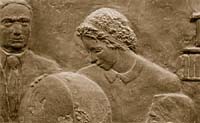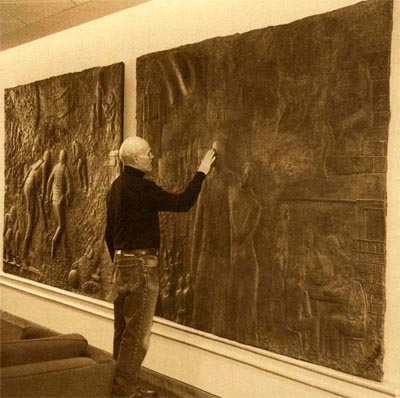| The
bas relief sculptures of "Promise" and "Anthem"
were dedicated as a memorial the Berman
Museum at Ursinus College (Collegeville, PA) by the War Years
Classes of 1942-1949. The sculptures are part of the permanent collection
of the War Years Lobby, Wismer Campus Center. The War Years Classes
were compelled to leave behind a legacy because of the impact of
World War II on their lives, the nation, and the world. The War
Years Classes raised over $3.2 million to help fund their memorial.
Thus, the bas relief sculptures stand not only as a symbol of the
war years, but also as a symbol of the generosity of the War Years
Classes. The message of these sculptures, while deeply personal
to those who experienced the campus and the effects of war, is also
a universal one that has an impact on the Ursinus Campus today and
will speak to future generations.
On the sculpture
"Promise" (shown above), the chapel, flag, and science building
are symbols of faith, freedom, and learning at Ursinus College. From their
campus surroundings, a central couple stands together, soon to separate,
facing the war with concern and apprehension, exemplifying courage and
idealism. Students on the steps of Freeland Hall symbolize any place students
gather in peace and tranquility. The interior of the library points to
an environment of tradition, history, and knowledge. The train leaves
from the Collegeville Station taking young Ursinus men to military bases.
"There is no hidden symbolism in "Promise" and "Anthem".
The story these bas reliefs tell is the one told to me and the same story
it will tell others who come to this college campus well into the future.
The images are literal and come together in a logical story in my mind.
I expect viewers to take these images and form a story based on personal
experiences. This campus -- in fact, every college campus -- is a proving
ground for young people. This era -- just as every time -- has its tests."
"For many, a college education is a means of getting ahead, preparing
for a career. "Promise" and "Anthem" are a reminder
that every student, every individual, has a destiny that is larger than
a job. We must eventually take our place in the history of humanity. Often
times, an era is defined by the price we pay or the sacrifice we make
in order to reach our destiny."
"The students on this campus in the 1940s were inadvertently at a
crossroads in the history of our nation and world. They were also at a
crossroads in their own lives, not unlike the students who arrive every
fall. Ursinus College was far removed from the bombs and killing a half-world
away and half a century ago. It would have been easy to become isolated
from the coming war, to ignore the tempest far away and to be immersed
in private lives and fortunes."
"The promise of their personal futures and the anthem of their response
to the tragedies and oppression in the world are the legacies of the War
Years Classes (1942-1949) at Ursinus College."
"I have tried to recreate in bronze the living joy, hope, anguish,
fear, and courage that typified the individuals, families, and communities
of the war years. It is not an insult to say Ursinus College students
were typical of their day. Our nation is fortunate that in one of the
darkest moments in world history, ordinary people responded in such determined
fashion that victory would be won in little more time that it takes to
complete college. The example of the ordinary heroes of the war years
leaves future generations to ask the recurring question: Can we rise to
the same level of sacrifice?"
"Today we are faced with choices similar to the students of the 1940s.
We must continue to leave the safety of our present to accomplish the
work of our future. Our situations are as diverse as the 50 years that
separate us, yet the threats and the opportunities are no less real."
"The paradox of the serene campus and chaotic battlefield are examples
of the peace and uncertainty we experience in our daily lives. The tranquility
of Bomberger Chapel and the terror surrounding the burning synagogue continue
to be reminders of the good and evil still present. Most importantly,
the people -- friends, wives, sons, professors, soldiers, corpses -- remind
us of our place in time."
"The sculptures "Promise" and "Anthem" are not
so much about events in history as they are about humankind's evolving
saga. Yet the work is rooted in the historical, as much a part of text
books as oral tradition. As this century comes to an end, what family
among us hasn't been touched in some way by the war years? The soldiers
were joined in the battle by the workers at home, young and old who could
not contribute helped with the sacrifices of things this generation has
never been without. It was a time when every individual was engaged in
a struggle for the basic values of human life: to live with freedom, morality,
and spirituality."
"For all its historical images, this work does not tell the story
of our past as much as it challenges us to form our future and fulfill
our destiny." - George Anthonisen, November 1998
|








